| Reviews & Columns |
|
Reviews DVD TV on DVD Blu-ray 4K UHD International DVDs In Theaters Reviews by Studio Video Games Features Collector Series DVDs Easter Egg Database Interviews DVD Talk Radio Feature Articles Columns Anime Talk DVD Savant Horror DVDs The M.O.D. Squad Art House HD Talk Silent DVD
|
DVD Talk Forum |
|
|
| Resources |
|
DVD Price Search Customer Service #'s RCE Info Links |
|
Columns
|
|
|
Paravision Dreams: The Golden Age 3-D Films of Pine and Thomas
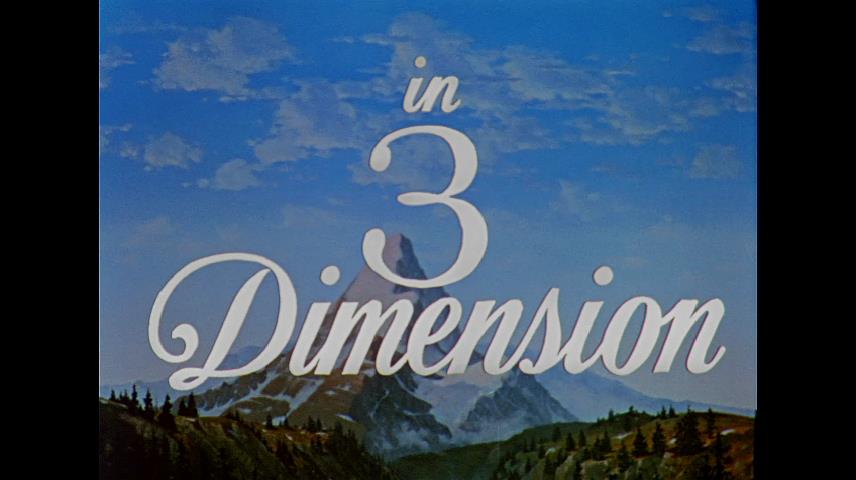 rn
rnAlthough much of the industry hoped that home 3D viewing would be popular from the likes of modern superhero and animated movies, us real film buffs were more excited by the prospect of classic 3D films from the 1950s being seen at home for the first time. More than ten years later, the industry has largely written home 3D off as a "failure" while die-hards like myself press on with whatever we can get. A bright spot has been that a good number of 50s titles have indeed been issued on 3D Blu-Ray, some with limited availability, and most of them made possible by Bob Furmanek and 3-D Film Archive. They restored the three Paramount movies included here, which have previously been issued individually but went out of print rather quickly. This new "Paravision Dreams" set gives those who missed the first releases another chance at having them.
I should say first off that these three discs are bit-for-bit identical to the individual releases, so if you have those already there's no reason to double-dip unless you really want to show your support for further releases, which isn't a bad idea. I reviewed two of the three before and will shamelessly steal from my previous reviews here. Neither this set nor the previous releases included any substantial liner notes, but the inner side of this set's cover explains a bit about Paramount's approach to 3D: they already had an experimental 3D camera setup which was perfected and called Paravision (short for Paramount Vision, which should have led to all of their further movies being shot in 3D as a standard). The three movies that resulted in 1953 were all produced by studio producers William Pine and William Thomas, known as "The Dollar Bills" who produced inexpensive movies that made a good amount of money for the studio. While 3D was accused of being a "gimmick" and used on "cheap exploitation films" form some studios, Paramount wanted it to be used mainly for providing depth to their films without calling too much attention to itself and that's largely what these movies do.
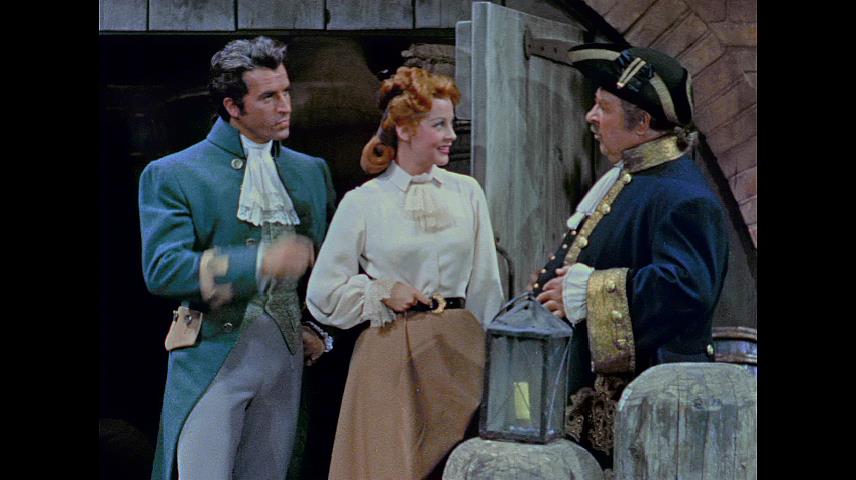
The first release was Sangaree, which in style is about as far as you can get from most of the other 3D movies of the era and truth be told isn't one of my favorites. It's a historical drama, set in Georgia after the Revolutionary War. Fernando Lamas (who also stars in this set's third movie Jivaro) is Dr. Carlos Morales, son of an indentured servant to General Darby (Lester Matthews) who owns a large plantation called Sangaree. The General is on his deathbed as the movie begins, and one of his last wishes is for Carlos to assume control of the estate- feeling that he'll do a better job running it than his children given his education. His son Roy (Tom Drake) who is right there agrees, but his daughter Nancy (Arlene Dahl, who later married Lamas in real life) strongly objects and takes the matter to court. The legal proceedings play out for a long while, then the matter of a plague comes into the story with some denial that eerily reminds one of the past couple years. Then pirates conspire to hijack a shipment of goods from the estate bound for overseas.
Sangaree didn't hold my interest much when I first viewed the initial Blu-Ray release and it's only been through repeat viewings for this review that I've grown to appreciate it for what it is. This simply isn't my favorite type of film and other than its being shot in 3D I would have had little to no interest in it otherwise. And those going in solely for the 3D may wonder why it was shot that way, when the subject matter hardly calls for it. The 3D here is more of a background player than star attraction, with the closest to any gimmick shot occurring when a barrel is thrown at the camera during a bar fight. But you could say that's how it should be, and likely how most movies in the subsequent years would have looked if the plans of some studios to shoot all movies in 3D had come to pass, rather than abandoned after numerous technical problems in shooting and projecting in theaters. I'll comment more on this in the technical section below.
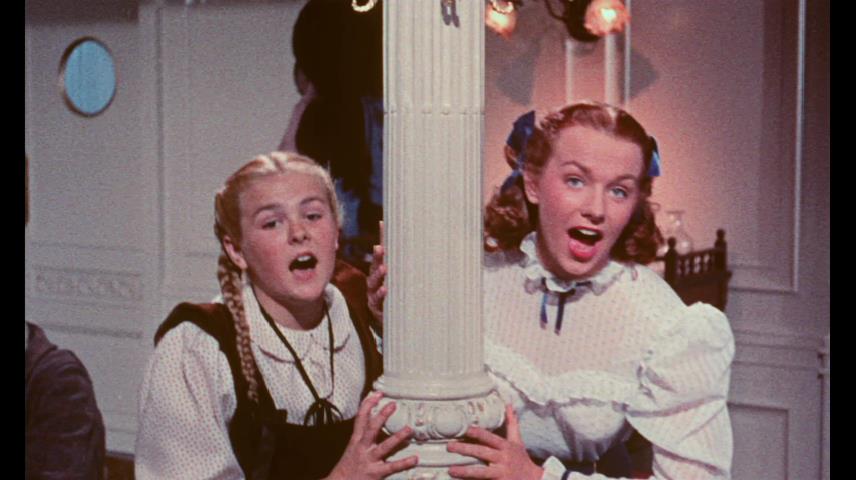
Our second feature is my favorite of the three, Those Redheads From Seattle. Billed just somewhat accurately as "the first 3-D musical" upon its 1953 release, Those Redheads From Seattle appears on 3D Blu-Ray as yet another title rescued from oblivion by the 3-D Film Archive. Set in 1898 during the Klondike Gold Rush, a "boomtown" called Dawson sprouts up in the Yukon territory with a casino called the Klondike Club being its social focal point. However there's still plenty of moral high ground in the town who don't approve of the gambling and burlesque shows going on there, and Vance Edmonds, a transplant from Seattle, often prints editorials about this in his newspaper. Someone at the club gets fed up with this and shoots him, hoping to put a stop to the paper altogether. Meanwhile back in Seattle, Vance's wife (Agnes Moorehead) is keeping their home under control with their four daughters, the youngest of them, Nell (Kay Strother, half of the singing group the Bell Sisters) being blonde but the other three redheads and the title characters: Connie (Cynthia, the other Bell Sister), Kathie (Rhonda Fleming, who you can also see in 3D in this set's third movie Jivaro and also in Inferno) and Pat (Teresa Brewer), who aspires to be a professional singer the most although the entire family is musically talented, partly at the insistence of their mother. Mom is quite strict and traditional however, wanting the girls to sing hymns at their church and not any of that immoral up-beat stuff- in this era it was also considered quite risqué for a girl to show as much as her ankle onstage as well.
Before he's shot, Vance mails a letter home saying that things are going OK for him but not great up north, so Mom decides for the whole family, including their pregnant cat, to make a surprise trip up to see him- not knowing that he's been shot since news traveled slow in those days (no email or cell phones, you see.) On the way up they meet Joe (Guy Mitchell, who likely could have inspired Harry Connick Jr.'s look a few decades later) who is also headed to Dawson to sing and dance at the Klondike Club. The girls take a liking to him right away, but of course Mom has her reservations. Kathie also quickly falls for the club's owner Johnny Kisco (Gene Barry), who knows who shot her father but isn't quite sure if he should reveal this- at least until the girls suspect him of it. Before that comes to a head however the girls integrate into the town rather quickly. The whole family has to decide what to do with the newspaper after Vance's death and stay there for a while, with Pat becoming a dancer at the club despite Mom's severe disapproval.
Five songs are performed in the movie, but I wouldn't quite call this a "musical" since my definition of that is when the cast breaks into song and dance spontaneously for the sake of the movie. Here all the songs are performed on stage or in other situations when they reasonably could have in the real world- for example the Bell Sisters sing "Take Back Your Gold" on the boat up north while playing a game that requires them to sing a song. There's a couple of good stage numbers at the club as well, of course played to the audience there. While this might not seem like a movie that calls for 3-D, it's used here in a way I haven't quite seen in any other movie of the past or present. The effect is quite strong the instant the Paramount logo opens with the familiar mountain pushed far into the screen with the stars and lettering pushed outwards. Through the entire movie this sense of depth remains not quite as strongly, but as obvious to the picture as the colors. There's a few well-placed 3-D gimmicks including characters subtly thrusting things they're holding at the camera, and an amusing sequence where barrels filled with liquor are shot with the contents gushing out towards the audience before a herd of booze-happy mountain men crowd around to catch it. Unfortunately by the time this movie made it to theaters, the technical problems of 3-D at the time had given the technology a bad name and Paramount gave theaters the option to play it in plain old 2D. Reports of some of the 3D engagements were less than enthusiastic as well, mainly from the two film projectors refusing to stay in proper sync. The extras on this disc tell that story.
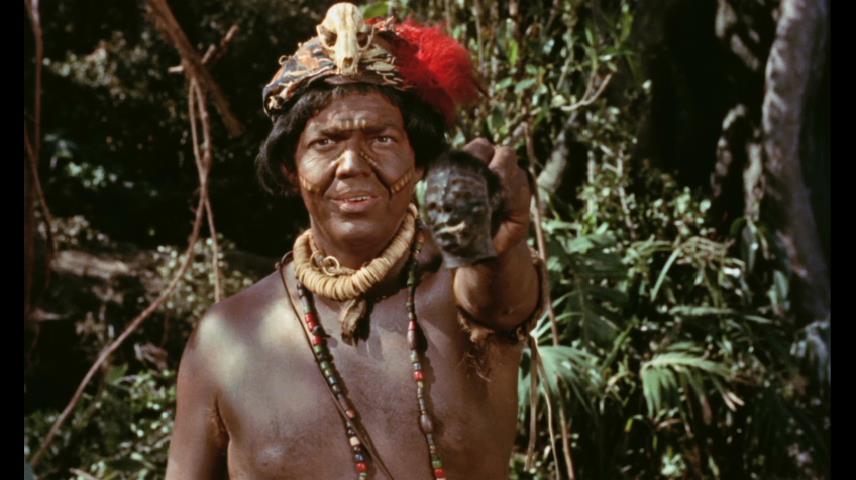
Finally we have Jivaro with two stars we've seen in our previous two features- Fenando Lamas and Rhonda Fleming, and directed again by Sangaree's Edward Ludwig. Having been produced under a few titles including "Lost Treasure of the Amazon" before ultimately settling on Jivaro for the savage natives of the story, Lamas stars this time as Rio Galdez who runs a trading post in a small South American town inhabited by locals and a few American misfits. He frequently trades with the local Jivaro tribe, as he seems to be the only one who can do so in a civilized manner. It's understood that nobody dare set foot in their territory, as they will immediately attack anyone who does. But some are tempted by the legend that a big stash of gold is hidden there in a place called the Valley of the Winds- some have ventured in and been killed, but others are still determined to find it. Vinny (Morgan Farley), one of Rio's associates, finds a map confirming this but Rio doesn't think it's legit.
Later Rio brings the American fiancé of local Jerry (Richard Denning), Alice Parker (Rhonda Fleming), in for a visit via a lengthy boat trip. Jerry has been away from her for about two years but has exaggerated a bit to her about the fortune he's been making in the area. When they arrive back in town, it turns out that Jerry has already ventured out into Jivaro territory to find the treasure. Rio gets a gang together to venture in and find him, but Alice insists on coming along also. Thus begins the real adventure of this movie, but it takes more than an hour of its 91-minute running time to reach that point. While this is hyped as the main part of the movie, the time it takes to get to it after many dialogue scenes will have many thinking "Get on with it already!" The performances are a bit on the campy side, especially from Lamas who exudes macho-ness and never keeps his chest covered. While this was supposed to be shot on location (and the first movie to do so in 3D), it was actually shot in Hollywood which is rather obvious with the fakeness of the mostly outdoor settings. Jivaro was shot near the end of 1953 when Hollywood's short-lived 3D mania began fading out due to numerous technical problems in theaters, and was thus released only in flat 2D never to be seen properly until 2006's 3-D Film Expo. What makes this all the more tragic is that although the use of 3D isn't really exploited, great attention was paid to the distance between the two camera lenses on each shot, known as the interaxial. Most films kept that distance about the same throughout, but here it was adjusted for each individual shot in order to make the effect most pleasing and effective.
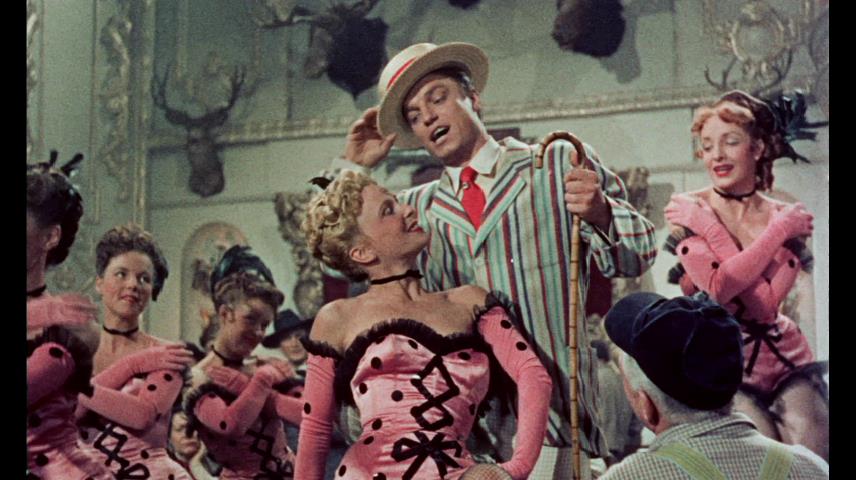 Picture and Sound:
Picture and Sound: All three of these movies were painstakingly restored by 3-D Film Archive and while they may not look completely perfect, once you learn of in how bad shape the elements were you'll be amazed that they look as good as they do here. As I mentioned earlier, Sangaree was an odd choice to shoot in 3D as it's mostly a dramatic film, but it creates a pleasing effect without hitting the audience over the head with it. In fact, I dare anyone who still dismisses 3D as a "gimmick" to watch this movie and keep that opinion. Only those who consider having to use 3D glasses a hardship could possibly find anything wrong with this movie being in 3D. On the flipside some 3D enthusiasts may be disappointed by the lack of things flying off the screen, but there are plenty of other movies that do that. Consider this the visual equivalent of the many 5.1 audio mixes out there that don't have any gratuitous surround or subwoofer effects, yet still lift the presentation above simple mono.
For reasons I can't find answers to at the moment, the right eye view was transferred from the original negative but the left was taken from an interpositive. The noticeable quality between the two varies only in a few moments, such as the opening scene where the left eye looked a bit more grainy especially in solid colors. The disc includes a 2D viewing option and while on most discs the default image is the left eye, in this case you see the right side when viewing in 2D as that was taken from the original negative. Viewing this in 2D is a different experience but it isn't obvious what you're missing. Interestingly the movie was intended to be shown in a 1.66 aspect ratio, but this disc presents it open-matte at academy ratio instead. The mono audio mix is presented in 2-channel DTS Master Audio and stays properly centered, fidelity of course is a bit lacking by modern standards but works well enough.
While the theatrical showings of Those Redheads From Seattle in 1953 might have had a few flaws, Bob Furmanek and company have seen to it that it looks as good here as it possibly can. They have pointed out that the biggest problem with this movie was the vertical alignment wasn't consistent throughout the film prints, causing one eye's view in some shots to appear higher up than the other. When a new film print of this movie was projected in Hollywood in 2006, the projectionist was said to have had to "ride" the framing knobs through the showing to keep them lined up- all of that has been done more precisely for this 3D Blu-Ray transfer.
This was also an early non-anamorphic widescreen film, shown in a 1.66 aspect ratio which is maintained on this disc. As for the quality of the picture itself, there's a definite graniness throughout which is likely inherent in how it was shot. The color doesn't quite "shine" the way you might expect, again partly from a likely intended look but also because of the shape the film elements were in. There's no sign of excessive film wear however, and this is another case where when hearing the challenges of making this transfer you'll be thankful for it looking as good as it does. The disc also includes a 2D viewing option which shows just the left eye's view, sampling this it appears watchable but really takes away a big part of the picture.
In the "premiere" venues the sound for Redheads was presented in discrete 3-channel stereo- the traditional stage channels but no surrounds. This was played off of a third machine in the projection booth from another reel of 35mm film with full magnetic coating- I got to see one of these in action at the Cinerama Theatre in Seattle. This of course also has to stay in perfect sync with the film projectors to work properly. The bad news is that like the WarnerPhonic track for House of Wax the multi-channel tracks for this movie have been lost, but the good news is that a fairly accurate re-creation was done from the existing elements. Encoded as a 3-channel DTS Master Audio Track, it's a lively mix with most of the music isolated to the left and right (I went up close to the center speaker a few times and heard no music at all in that channel, similar to more recent digital mixes) with some dialogue and sound effects also venturing into the left and right. The levels of the left and right channels on this disc seem to be a bit higher than the center however, with music often drowning out dialogue, and I found on my current setup's default settings surround audio is derived from the front channels which isn't what was intended and should be manually adjusted. There's also a transfer of the mono track available, in 2-channel DTS Master Audio that stays centered as it should.
Jivaro is also framed at a 1.66 aspect ratio and the picture is very clean for the most part. Color is rather light but this is likely its intended look. The only noticeable imperfection is the dip in quality noticeable in shots that are transitioned using dissolves, an effect common on older films. The 3D doesn't really call attention to itself (the disc does include a 2D viewing option, and viewing it that way it isn't obvious that you're missing anything) but provides a more immersive experience. It's likely that had 3D movie production continued in that era, the emphasis would be more on this immersion than gimmicky "out-of-the-screen" effects- there's only one obvious shot of that here but also a few missed opportunities, and an effort that doesn't quite work (when Rio unpacks some folded fabrics). The 3D is still far stronger than most recent digital 3D productions, and certainly makes you feel more like you're in the actual location rather than just watching it on a screen. A subtle use of 3D is the layering of many shots, placing many objects in the foreground, a middle layer with the main action, and the background behind them. Unfortunately this also makes the fakeness of the studio location and rear-projection effects all the more apparent. Another such subtlety is during scenes involving rain, some of it appearing to be falling in front of the screen. A few shots are set up with the actors walking into the frame, with an interesting effect during the movie's climactic battle.
The mono audio track is presented in 2-channel DTS Master Audio and stays properly centered if you have your sound system set to do so. The quality isn't the best but about on par for a modest production of this vintage; dialogue is reasonably clear but overall it's a bit below high fidelity standards.
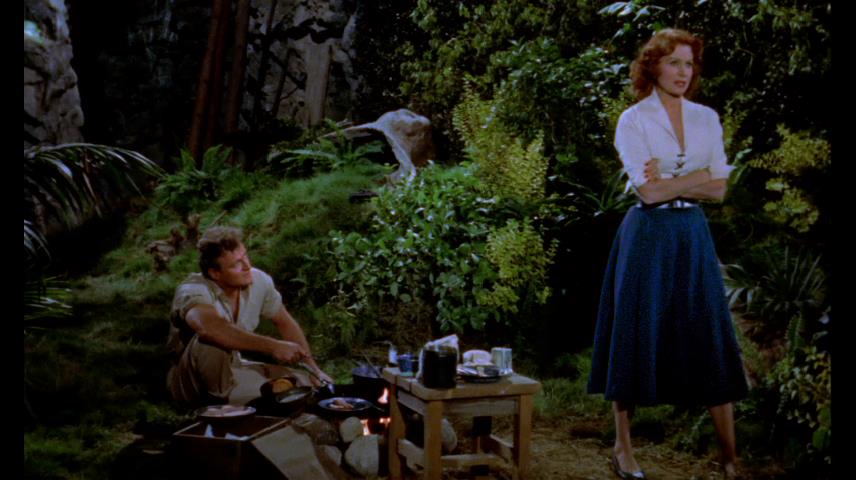 Extras:
Extras: As mentioned earlier, all of these discs are identical to the individual releases and include the same extras. Sangaree includes a silent restoration demo where film transfers are shown in various clean-up stages, from the condition they arrived in to the final transfer used for the disc. Again, it's amazing what Furmanek and company were able to do here. Two trailers for the movie are included, one of which sells the movie on its own with no mention of 3D and the other (in an analog video transfer full of dot crawl) hypes the 3D but doesn't show any actual footage from the movie- instead Lamas and Dahl comically try to explain 3D in a 2D presentation to an audience who assumedly has never seen 3D. Finally there is an hourlong radio dramatic adaptation of Sangaree that was part of a series of dramatizations to promote current movies- rather odd as radio dramas were fading at this point after the introduction of TV, and of course movie theaters were losing audiences to TV and came up with 3D as a way to get them back. The copy used here was used for Armed Forces radio and in the place of the original commercials we hear some interesting "public service announcements" for American service people interacting with those in the countries they are serving in. A still image of a newspaper ad promoting this show appears onscreen for the duration.
A very informative commentary track accompanies Those Redheads From Seattle- most of it with Hillary Hess with 3-D Film Archive's Bob Furmanek and Jack Theakston with Greg Kintz appearing in a separately-recorded portion around the middle of the film. While they talk a bit about the movie itself including the story and the actors, the main focus is on the technical aspects which of course delighted me and likely will anyone else interested in the history of 3-D filmmaking. They give plenty of time to the problems the 3-D presentation had, reading quotes from reviews of the first showings. I'd always found it a bit frustrating that the industry gave up on 3-D for so long after that, as it seems the problems with it were so notorious but I haven't heard anything about what was done to fix them until digital projection came along decades later. The work done to restore the movie for this disc is discussed as well, with the statement "this was a really tough film to bring back to life" summing it up.
Separately there's a 3D segment with Greg Kintz talking more about the restoration, showing before and after comparisons of a few shots showing the alignment problem as well as the faded color and general poor condition of parts of the film. A "Stereophonic Sound Demo" is kind of a waste of time, as it just re-plays Guy Mitchell's "Chick-A-Boom" number inside a graphic of a theater screen with analog waveforms on the sides and above the picture- I would have liked to have seen how the mix was actually done instead. In 2D there's an interview with star Rhonda Fleming at the 2006 Hollywood showing of the new film print, and the theatrical trailer is included (in 2D but flagged for 3D) from an analog video source with a lot of dot crawl and appearing to be stretched from 4x3. Amusingly it includes text saying the movie is actually in "4-D" with "4 Delightful singing stars". A 1970s porn film called The Starlets later used the term "4-D" in its advertising, with the fourth dimension being something not suitable for family discussion.
3-D Film Archive's Jack Theakston and Hillary Hess share a wealth of information in another commentary track for Jivaro about the movie's 3D photography and other aspects of its production. As in previous Archive commentaries there's a cut-in halfway from Mike Ballew and Greg Kintz with information on how the movie was restored for 3D viewing here although it isn't mentioned how easy it was to find both the left and right eye views given that this was never publicly shown in 3D until 50 years later.
An 8-minute segment from the movie is also presented with a shot-by-shot analysis, with text appearing onscreen showing the date and camera specs on each shot. A 2D trailer for the movie is also included (but the disc is still flagged for 3D so you can keep your glasses on during this, as the display will keep its settings for them and otherwise be too bright) along with a 3D teaser for The Maze and 2D trailers for Cease Fire, Sangaree and Those Redheads from Seattle (the same dot-crawl-infested transfers found on the previous discs).
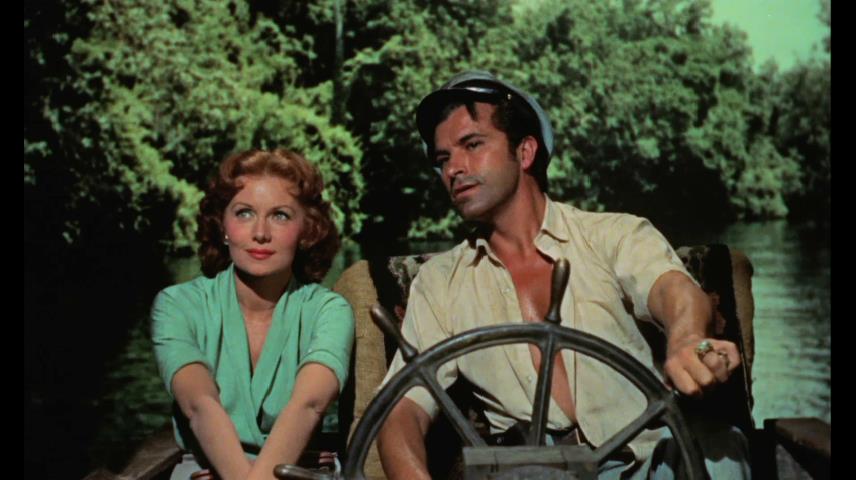 Final Thoughts:
Final Thoughts: Any fan of 3D owes it to themselves to have all of the classic 1950s titles that have been put out on Blu-Ray disc; if you missed one or more of these the first time they were issued then this set, which sells for less than half of what two of the previous discs sold for together, is a must-have. If you've already bought all three releases before though, you won't be missing anything by passing on this. It's a shame this set couldn't have come out much earlier when 3D displays were plentiful; it would have been a great introduction to 3D for many consumers. With the state home 3D is in now, I try to support it all I can by buying every 3D title that has been released. Furmanek's 3-D Film Archive doesn't seem too heavily deterred by the sad hardware situation however; he has hinted that there are still many more restorations like these to come and I'll be picking up all of them.
Jesse Skeen is a life-long obsessive media collector (with an unhealthy preoccupation with obsolete and failed formats) and former theater film projectionist. He enjoys watching movies and strives for presenting them perfectly, but lacks the talent to make his own.
|
| Popular Reviews |
| Sponsored Links |
|
|
| Sponsored Links |
|
|
| Release List | Reviews | Shop | Newsletter | Forum | DVD Giveaways | Blu-Ray | Advertise |
|
Copyright 2024 DVDTalk.com All Rights Reserved. Legal Info, Privacy Policy, Terms of Use,
Manage Preferences,
Your Privacy Choices | |||||||













